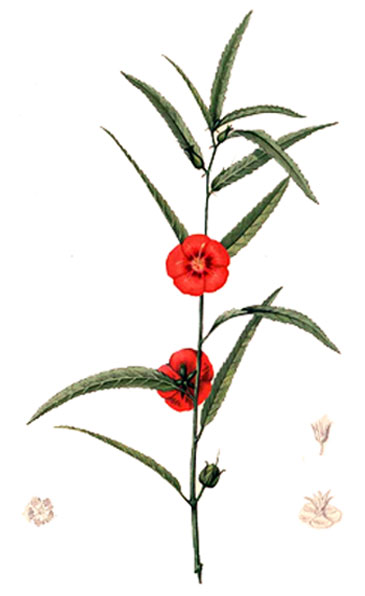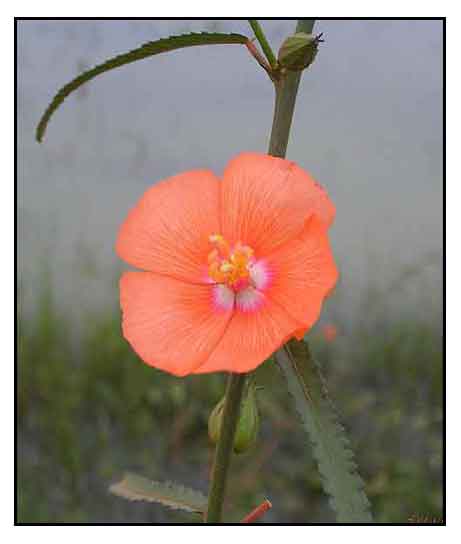 Gen info Gen info
- Pentapetes is a genus of flowering plants in the family Malvaceae. It contains a single species, Pentapetes phoenicea.
- The "Midday Flower" or "Noon Flower" name refers to its opening around noon and closing early morning the next day.
Botany
Limang-dahon is an erect, half-woody plant, 0.5 to 1 meter high. Branches are long and spreading. Leaves are alternate, linear, 6 to 10 centimeters long, toothed at the margins, usually having a broad, pointed base, tapering to a pointed tip. Flowers are borne in axils of the leaves, with 5 large, deep rose, and showy petals. Fruit is five-valved, rounded, with a hairy capsule 1 centimeter in diameter. Seeds, which are not winged, occur 8 to 12 in two series in each cell.
 Distribution Distribution
- Native to the Philippines.
-
In Cagayan, La Union, Quezon, Bataan, Pampanga and Laguna Provinces in Luzon, and in Samar, Negros, and Mindanao.
-
In open and damp grasslands.
- Occasionally cultivated.
- Also native to Assam, Bangladesh, Cambodia, China South-Central, China Southeast, India, Laos, Malaya, Myanmar, Nepal, New Guinea, Sri Lanka, Thailand, Vietnam. (2)
Constituents
- Phytochemical analysis of stem, leaf, and root extracts yielded alkaloids, flavonoids, saponins, steroids, phenolics, coumarins, and triterpenoids. (7)
- Phytochemical screening of leaf extract yielded tannins, flavonoids, sterols, saponins, carbohydrates, and traces of alkaloids.
(16)
Properties
- Fruit is mucilaginous.
- Root considered astringent, antibilious, antiphlegmonous.
- Plant is considered aphrodisiac, astringent, carminative, demulcent, detoxicant, emollient, mucilaginous, purgative, cathartic, thermogenic.
-Studies have suggested hypoglycemic, antioxidant, cerebroprotective, neuropharmacological properties.
Parts used
Fruit, roots.
 Uses Uses
Edibility
- In Celebes, leaves used as tea substitute.
Folkloric
- Decoction of fruit used as emollient.
- Root used to alleviate wind and fever.
- Santals use the plant as astringent, antibilious, antiphlegmonous and to alleviate fever.
- Plant is demulcent and used for snake bites.
- In Annam used for its emollient property.
- Used for coryza.
- India's ethnic people of Andhra Pradesh use root decoction, twice daily, for burning micturition. Local healers used the milky juice for skin diseases, leucoderma.
- In Mizoram, India, decoction of leaves drunk for inflammatory glands. Juice also applied to inflammatory glands. (6)
- In Bangladesh, garland of flowers worn around the neck as treatment for fever. (5) Juice from macerated flowers of P. pheonicea combined with oil obtained from the leech, Hirudo medicinalis, used for treatment of sexual disorders—massaged onto the penis or vaginal area at night for 7 days. (9) Women from the Khumi, Marma and Tripura tribal communities use the root juice, extracted through rubbing in stone, twice daily for a week, for irregular menstruation. (13) Leaves used for the treatment of boils. (22)
- In Dumka (Bihar), flowers are pounded together with kamal and kumudini and given to females with general weakness after menstrual cycle. (12)
- The Tripura tribe of Northeast India
used cooked tender shoots in the treatment of nephritic disease. (15)
- Flower paste used to cure abnormally heavy menstrual flow. Mucilaginous capsules given for diseases of the bowels. Fruit decoction used as emollient.
(17)
- In Bangladesh, juice from macerated flowers is mixed with oil obtained from leeches, Hirudo medicinalis, massaged onto penis or vaginal region for sexual disorders, twice daily for 7 days. (18)
- In Bundelkhand, India, roots used as antidote for snake bites. (23)
Others
- Traditional Chinese Medicine: P. phoenicea is a component of a multiherbal traditional Chinese medicine used for treating exfoliative dermatitis type of drug reaction. (11)
Studies
• Brine Shrimp Lethality Assay / Safety: Studies on various fractions of leaves of P. phoenicea showed none of the extracts to be toxic up to a dose level of 600 µg/ml. Results suggest P. Phoenicea can be used safely for its traditional claims. (4)
• Hypoglycemic Potential: Studies evaluated the hypoglycemic effect of 70% alcoholic extract of Pentapetes phoenicea in experimentally induced diabetic rats. Results showed significant dose dependent lowering of blood glucose in STZ induced hyperglycemic rats. Effect may be related to tannins, terpenoids, sterols and flavonoid contents. (8)
• Hypoglycemic Activity / Antioxidant / Leaves: Studies evaluated the in-vitro antiradical property using DPPH test and in-vitro α-amylase inhibitory activity to establish in-vitro hypoglycemic potential of various fractions of leaves. Results showed promising antiradical property. Aqueous and ethyl acetate fractions showed α-amylase inhibitory activity attributed to flavonoids, tannins, and saponins in the fractions. (10)
• Cerebroprotective: Study evaluated the cerebroprotective activity of a methanolic extract of P. phoenicea in a global cerebral ischemic model induced in male albino Wistar rats by temporary bilateral carotid artery occlusion. Results showed treatment with P. phoenicea enhances the antioxidant defense against BCAO-induced global ischemia/reperfusion and exerts cerebroprotection. In P. phoenicia treated groups, there was significant restoration of biochemical parameters in a dose-dependent manner. (14)
• Neuropharmacological Effects: Study evaluated the neuropharmacology of Pentapetes phoenicea using rats and mice in models of seizures, spontaneous activity, exploratory behavior and motor coordination. The extracts elicited significant prolongation of pentobarbitone-induced sleeping time, reduction in spontaneous motor activity and exploratory behavior. The extract also prolonged the onset of seizures and caused significant muscle relaxation. The underlying mechanisms was assumed to involve GABAnergic activity. (19)
• Neuroprotective in Hypoxia: Study evaluated the cerebroprotective effect of methanolic extract of Pentapetes phoenicea in hypoxic rats. The ME (200 mg/kg) significantly reduced (p<0.001) escape latency (25.4) in water maze task and significantly increased locomotor activity. P. phoenicea restored the reduced levels of glutamate and dopamine brain enzymes and significantly decreased acetylcholinesterase (AChE) activity. Antioxidant enzymes SOD, glutathione peroxidase, glutathione reductase, and catalase levels reduced by hypoxia were significantly restored, along with hypoxia induced lipid peroxidation. (21)
Availability
- Wild-crafted.
- Seeds in the cybermarket.
|

![]()




 Distribution
Distribution
